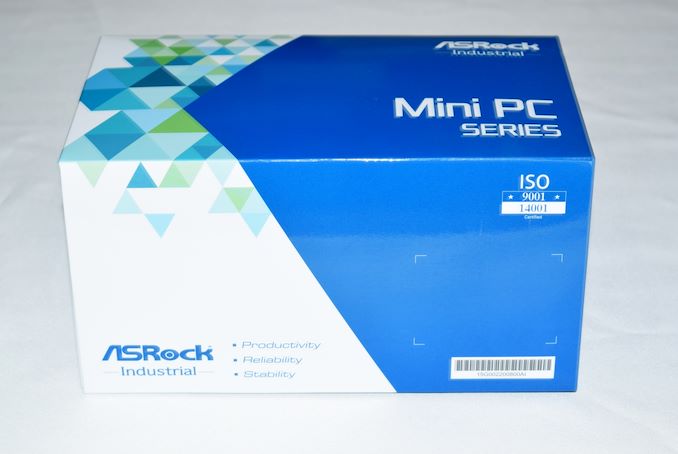ASRock Brings Zen 2 NUC : 4X4 BOX-4800U Renoir Mini-PC Reviewed
by Ganesh T S on November 25, 2020 11:00 AM ESTConcluding Remarks
NUCs such as the 4X4 BOX series from ASRock Industrial have enabled AMD to participate in the burgeoning UCFF PC market. ASRock Industrial has quickly learnt from its mistakes in the 4X4 BOX-V1000M - the 4X4 BOX-4000 series brings support for M.2 2280 PCIe 3.0 x4 NVMe SSDs (compared the M.2 2242-only support in the previous generation). The WLAN component is also the best that is available in this particular form-factor (2x2 Wi-Fi 6 compared to the 1x1 Wi-Fi 5 card in the previous generation). Reducing the physical footprint of the system is also welcome. The fan curve / noise profile has also improved.
The key face-off for the 4X4 BOX-4000 series is against systems based on Comet Lake-U. Tiger Lake-U is on the way, but no UCFF system based on TGL-U is currently available for purchase. To get a good idea of how Renoir compares against Comet Lake, we went back to our Frost Canyon NUC sample and revamped its internals to match the ASRock-suggested 4X4 BOX-4800U configuration. We replaced the 16GB DDR4 SODIMMs with 64GB DDR4-2666 SODIMMs (maximum supported frequency in CML-U) and the 256GB Kingston A1000 with a 1TB Crucial P5 SSD. On the pricing front, the two systems end up costing almost the same when the storage and RAM are also considered. The preceding pages presented benchmarks that are essentially apples-to-apples comparison.
The user experience with SFF desktops relies on multiple pillars - single-threaded performance, multi-threaded performance, energy efficiency, and last, but not the least, driver/software support. In the last few years, Intel has stalled a bit in delivering improvements in these pillars from one generation to the next. With the first-generation Ryzen, we saw AMD tackling the multi-threaded performance aspect with aplomb. Zen 2 has delivered updates across the first three of those pillars - single-threaded performance improvement is good enough to actually challenge CML-U across a large number of workloads within the power envelop dictated by the form factor of NUC-like systems. The 7nm fabrication process has delivered power efficiency gains, though it still doesn't match Intel's when it comes to race to idle (as shown by the gulf in the idle power numbers for the Frost Canyon NUC and the 4X4 BOX-4800U). It is in the drivers/software segment that AMD gives us cause for complaint. For example, we faced issues playing back YouTube HDR content in MS Edge (with Windows 10 20H2 and the latest AMD drives), and madVR usage resulted in playback issues. Both of these might well turn out to be application bugs over which AMD may not have control. But that is scant consolation for the end-user. It is an unfortunate fact that most QA is done on Intel-based systems, leaving the experience with AMD systems a little less than ideal. Hopefully, with AMD gaining market share, these types of software compatibility issues become a thing of the past.
On the pricing front, the barebones version of the 4X4 BOX-4800U is available for $600 - it pretty much matches the launch price of the Frost Canyon NUC10i7FNH. For the same price, the Renoir NUC surpasses the CML-U system by including support for NBASE-T with a 2.5 Gbps LAN port (backed by the Realtek RTL8125BG controller), native support for DDR4-3200 without overclocking, and support for four simultaneous 4Kp60 display outputs. Intel will be playing catch-up with TGL-U here, but at the moment, the 4X4 BOX-4000 series wins the features-per-dollar battle. Given the benchmark numbers we have just seen, the performance-per-dollar metric is also firmly in favor of the 4X4 BOX-4800U. On the performance-per-watt front, there is still scope for improvement. Overall, the ASRock 4X4 BOX-4800U has given us the opportunity to finally evaluate an AMD NUC that can go head-to-head against Intel's current flagship in the same market segment. This has been a remarkable turnaround for AMD. The renewed competition in this market is also excellent news for consumers.












53 Comments
View All Comments
watersb - Saturday, December 19, 2020 - link
Thanks.The motherboard looks like PC-104, without the funky stack connector.
mars2k - Tuesday, December 1, 2020 - link
Why no Blu-Ray playback? What do they think we're supposed to do?kapqa - Friday, October 8, 2021 - link
Thank you, very informative.It would have been nice to have the Ethernet Speed&Behavious test included in the Network Capabilities Analysis.
Looking forward to see some interesting devices yet to come.